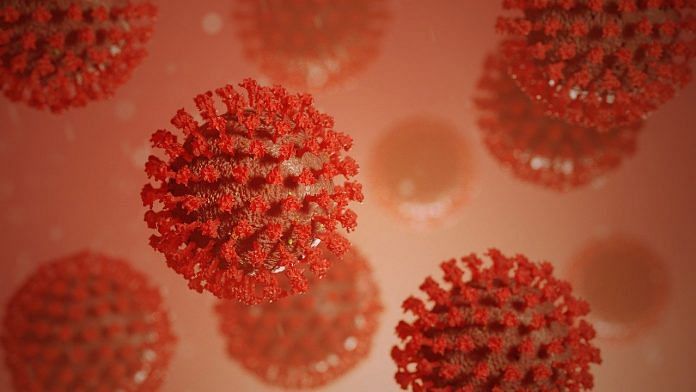New Delhi: A new lineage of the SARS-CoV-2 virus, called B.1.618, has been identified in India, which is predominantly circulating in West Bengal.
This is the second lineage to be identified from India, the first being B.1.617, also known as the ‘double mutant’ virus, according to a Twitter thread by Vinod Scaria, a researcher at the Council of Scientific and Industrial Research’s Institute of Genomic and Integrative Biology (CSIR-IGIB) in New Delhi.
B.1.618 – a new lineage of SARS-CoV-2 predominnatly found in India and characterized by a distinct set of genetic variants including E484K , a major immune escape variant. pic.twitter.com/dtfQJp2S2B
— Vinod Scaria (@vinodscaria) April 20, 2021
The earliest sequence of this lineage was isolated on 10 October last year from a patient in West Bengal. While the lineage is mainly found in India, variants have also been found in the US, Switzerland, Finland and Singapore.
Also read: India has a double mutant Covid virus variant. Here’s everything you need to know about it
How mutations happen
Mutations in viruses are not uncommon — several new lineages and variants of the SARS-CoV-2 have been identified across the world.
Every living organism is run by a predefined set of genes that ‘instruct’ cells how to build proteins. Understanding the sequence of genes is thus like cracking the code to the organism and how it functions.
The genetic material of the coronavirus is ribonucleic acid (RNA) strands. Each virus has about 26,000 to 32,000 bases or RNA “letters” in its length.
These letters — A, C, U and G — stand for adenine, cytosine, uracil and guanine. These molecules are the fundamental units of the genetic code. How A, C, U and G are arranged in the genetic code determines what proteins are expressed by the organism.
Not all mutations in the SARS-CoV-2 translate into changes in the virus.
The genetic code is read in sets of three letters, together known as codons. Each set of three letters ‘translates’ into an amino acid, which are compounds that form the building blocks of proteins. You can read more about how these ‘letters’ translate into amino acids here.
What’s different about B.1.168?
The B.1.168 variant is characterised by the deletion of two amino acids in the spike protein — described as H146del and Y145del. Both of these are linked to immune escape — that is the ability to escape a person’s immune system even if they have been exposed to the virus before and have the capability to produce antibodies against it.
Scaria wrote that Y145 and H146 are not part of the proteins interacting with the human ACE2 receptor — the protein that facilitates the entry of the SARS-CoV-2 virus into the cell.
The structural impact of the deletion of the two amino acids on the spike protein is yet to be understood completely, he added.
Along with these two deletions, the B.1.168 lineage also carries the D614G mutation in the spike protein, which has been earlier associated with increased infectivity.
The lineage also has the E484K, a major immune-escape mutation also found in a number of emerging lineages across the world.
According to Scaria, E484K can escape multiple monoclonal antibodies that are being used as Covid-19 therapies, as well as convalescent plasma (taken from recovered Covid patients).
“There are many unknowns for this lineage at this moment including its capability to cause reinfections as well as vaccine breakthrough infections. Additional experimental data is also required to assess the efficacy of vaccines against this variant,” Scaria wrote on Twitter.
Impact in Bengal
The proportion of SARS-CoV-2 samples of the B.1.618 lineage has been increasing in West Bengal since January. However, Scaria added that at the moment, there is no conclusive evidence that this is the lineage driving infections in West Bengal.
“More focused epidemiological investigations would address these questions,” he said.
Genome sequencing data has been shared by researchers from National Institute of Biomedical Genomics in West Bengal on GISAID — a global science initiative established in 2008 that provides open-access to genomic data of influenza viruses, and now the coronavirus responsible for the current pandemic — so that this lineage can be further investigated.
(Edited by Shreyas Sharma)
Also read: ‘Highly infectious’ double mutant strain was circulating in Uttarakhand even before Kumbh began



